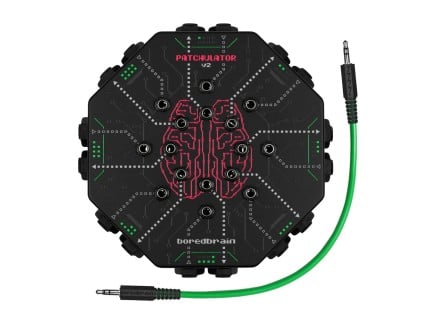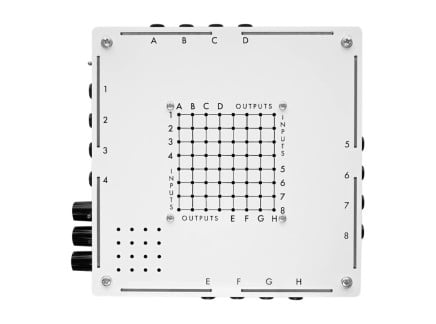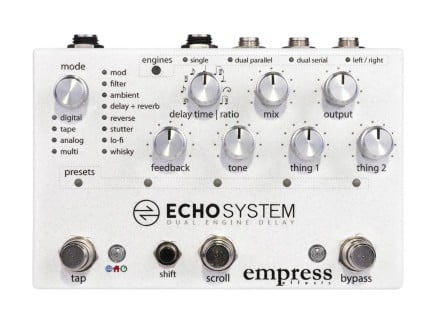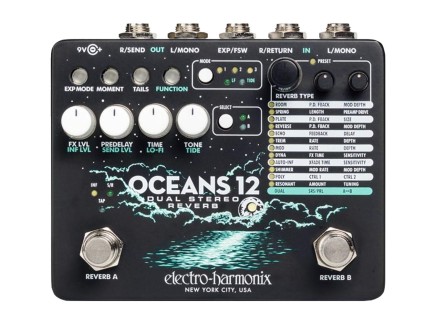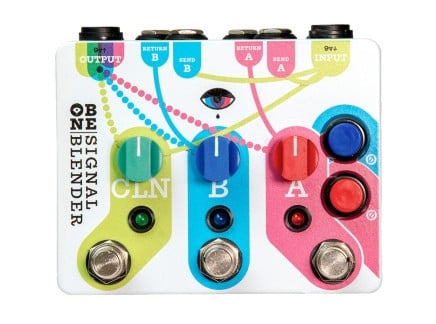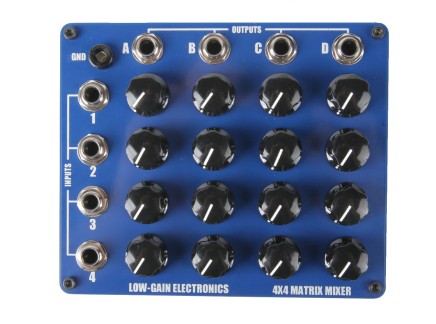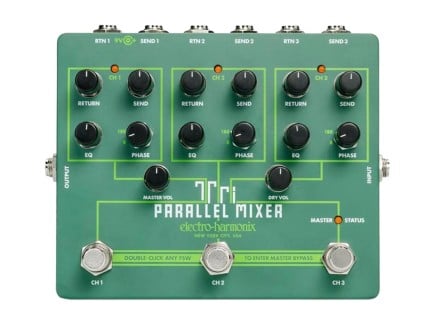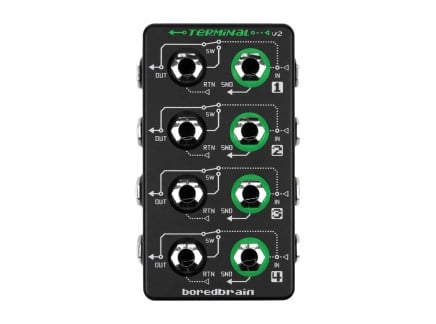It's a question nearly as old as time itself: "what order should effects pedals be in?"
As cliché as it sounds, there really are no strict rules as to how your effects should be connected together—music is a creative endeavor after all, so why impose hard constraints on yourself and potentially shut out neat ideas? That being said, there are some common, tried-and-true ways to connect your pedals together, and understanding how and why those work in traditional setups leads to deeper comprehension and better results when experimenting with alternative orders.
In this article, we'll go over standard pedal signal flows, before opening things up and providing suggestions for how to deviate from the norm. Pedals might not be as immediately flexible as patching up a modular synthesizer or rearranging VSTs in a DAW, but we'll also talk about some ways to inject some spontaneity into your effects chains, and considerations for planning out creative signal routing and pedal arrangements.
Traditional Effects Order Overview
There's a ton of different pedals out there, but I like to think that most effects can be consolidated into three main groups, with a few fringe categories that require particular placements within a pedalboard that work best. Even within these groupings, it's worth exploring different pedal orders to find what's best to your ears. To keep things relatively simple, I tend to break things down as follows: dynamics and shaping pedals first, followed by modulation effects, and finally spatialization at the end. Thinking about effects in this way more or less resembles how real-world, acoustic sounds are generated and then modified by the natural world as they travel to our ears.
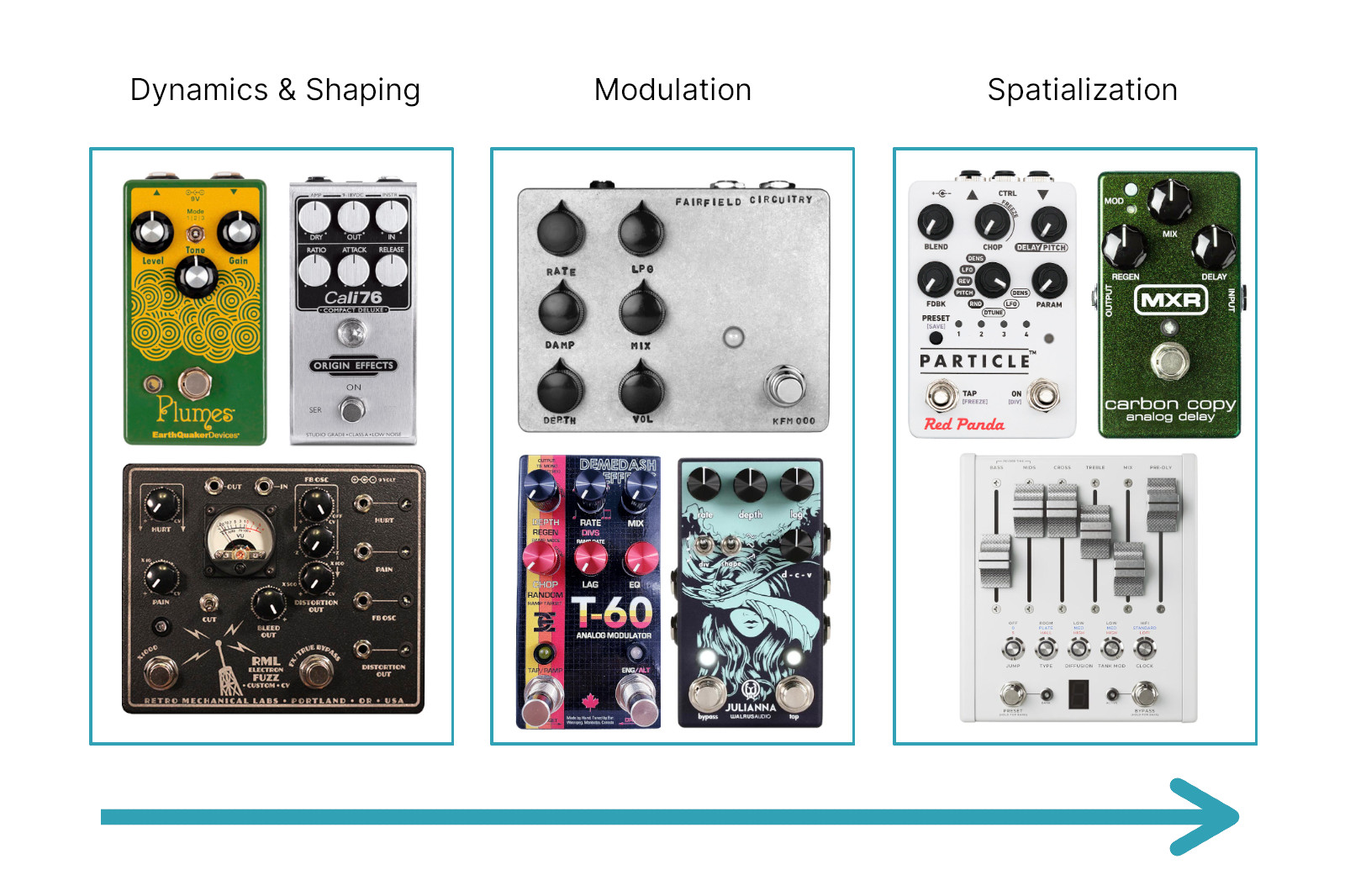
The most obvious kind of pedal I'd consider to be part of the dynamics and shaping group is the broad category of gain pedals, including boosts, overdrives, distortions, and fuzzes. In the guitar world, stacking gain stages in various ways can lead to a number of different sounds that are uniquely yours. Of course, many of these pedals operate within a spectrum of uses, ranging from clean boost through overdrive and on to distortion or fuzz. Many guitarists treat gain pedals like spices in their pantry, or various hues in their palette of sounds, and it's very common to experiment with connecting gain stages themselves in different orders for different tonal results. As such, we could likely write an article's worth of tips and considerations for stacking drives, but as a general rule of thumb: placing a boost before a drive pedal will push it even further into saturation, while a boost after a drive pedal will simply increase the volume of your signal.
Other pedals that fit into this group are compressors and anything which acts like a filter, including wah pedals. Given that compressors directly manipulate the dynamics of the signal passing through them, they're commonly placed as the very first pedal on a board, or at least very close to the beginning of the signal chain, with wah pedals placed before them and any number of drive pedals after.
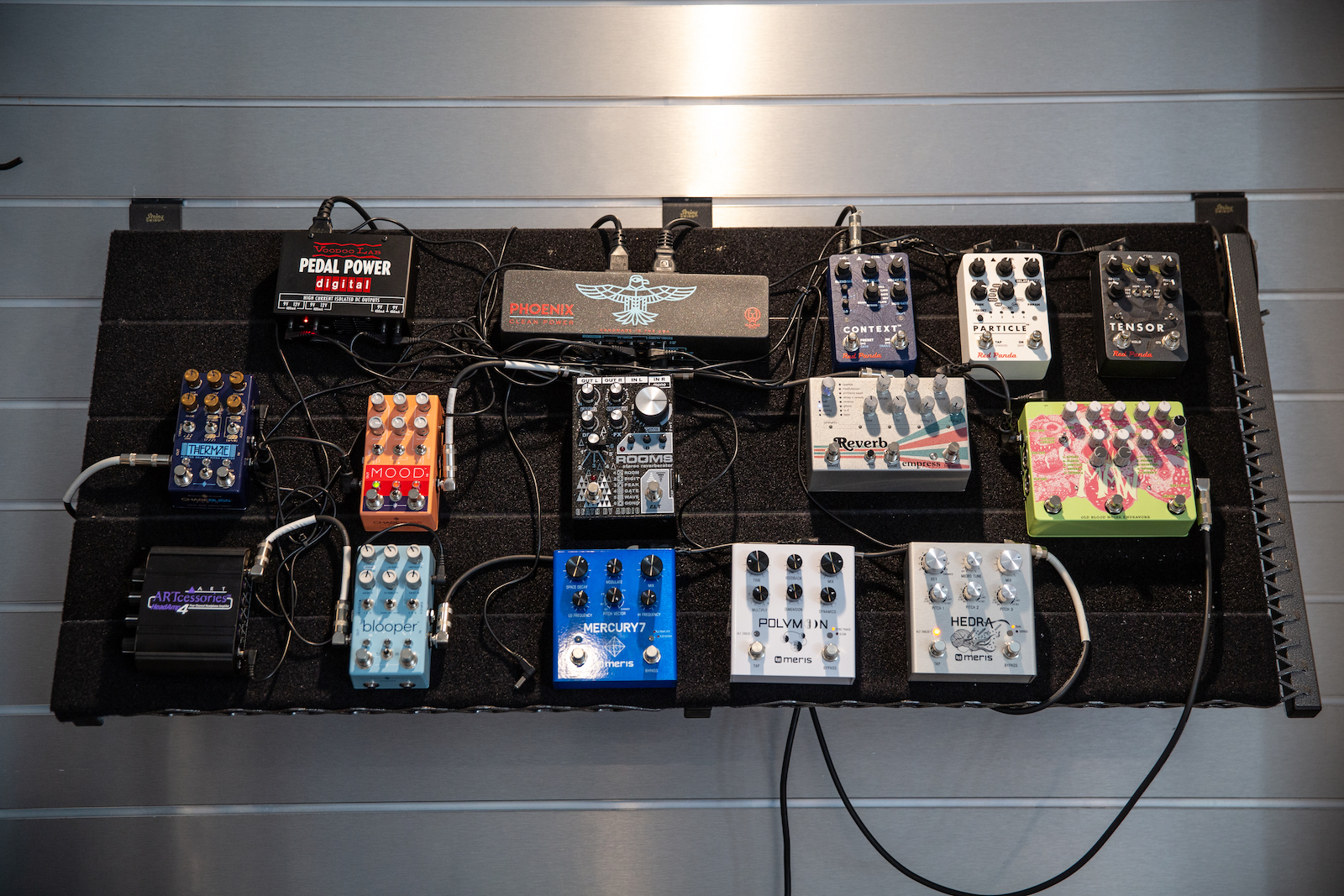
Next, modulation pedals could be considered something of a catch-all category, as they cover everything from phase shifters and flangers to chorus, tremolo, and more. If it isn't any of the pedals listed in the dynamics section or some kind of delay or reverb, I'd consider it some form of modulation. Since a lot of these kinds of pedals are built from specific types of filters and super-short delays, they figuratively and literally fit into this middle section between dynamics and spatialization. Again, even within this category, it's well worth exploring different effect orders—you'll get dramatically different results from running your ring mod into your vibrato rather than vibrato into ring mod.
Finally, spatialization is the last main block of effects, covering delays, reverbs, and anything which might affect panning or stereo image. Like the sound of yodeling bouncing through the mountains or clapping your hands in an empty gymnasium, this section represents the journey your instrument's audio waves take through imaginary space. When sound is bouncing and reverberating around in space before reaching your ears, this is when echoes, diffusion, and other transformations occur to the waves emanating from the original source. Through the use of these kinds of effects, position and distance are portrayed to the listener.
I mentioned above that there were some types of pedals which require particular attention to where they're placed in the effects chain. Other things like pitch shifters work best with as clean of an input signal as possible, so they should usually be placed towards the front as well, but perhaps after compressors. Similarly, certain fuzz pedals which are highly sensitive to input impedances usually like to be as close to the guitar or other instrument as possible. On the other hand, loopers tend to be most effective at the very end, whether you're using a more traditional option like the Boss RC-1 or mangling your audio with the Vongon Polyphrase.
Considerations for Experimentation
With all of the above in mind, it's easy to adopt a philosophy of "if it ain't broke, don't fix it," but I think this misses out on a world of creative ideas and opportunities. There's a time and a place to respect tradition, but a significant element of your artistic voice could be hiding within a specific combination of effects that you haven't tried yet. In the following paragraphs, I'll share a few things that I like to think about when I'm experimenting with the order of my pedals.
For me, I think my background as a guitarist has had a significant impact on some of the more creative ways I like to incorporate drives and compression at the end of a signal chain. When I used to play in bands with loud drummers, I got used to cranking my amp a bit to cut through the mix, but in doing so I would end up slightly driving the amp before pedals were even involved. Of course, some amps are particularly desirable in their nonlinear tendencies as they approach the ceiling of their headroom and break up into compression and overdrive. This means that setting up an entire pedalboard before the input of an amp, including reverb and delay effects, can impart interesting clipping, compression, and limiting effects when long trails and echoes push into the preamp. But using amps, drive pedals, and even just compressors in various places along the signal chain can sculpt tones in helpful or unexpected ways.
 My Signal Chain
My Signal Chain
For an example of what I'm talking about, here's a breakdown of how I've been using some of my effects at home in this way. The chain itself is simple—I'm starting with an Empress Compressor MkII for some general dynamics shaping, which is helpful for maintaining clarity and note definition on seven and eight-string guitars. Next is my trusty Boss DD-5 delay pedal, which is an earlier version of the current DD-8, and is used for general delay purposes, although its reverse mode is a lot of fun, too! From there, another compressor in the form of a Boss CS-1, now available as the CS-3 serves as a post-delay compression tool and dynamically squish large swells of delay. Finally, by integrating Eurorack modules through a Strymon AA.1, I'm also using a (now-discontinued) Beads from Mutable Instruments as an all-in-one granular processor, reverb, and tape-style saturation effect, before running into my audio interface, which is a Universal Audio Apollo with their UAD Marshall Plexi Super Lead plug-in running on one of its Unison preamps.
At first glance, the dual compressor setup might be a bit of a surprise, but running one for more general purposes and then another after a delay was a trick I picked up while playing in a sort of psychedelic rock band. While I'm now using a digital delay that's fairly tame, I previously used an MXR Carbon Copy, on which I would frequently kick the repeats into self-oscillation for dramatic effect, and a compressor after the delay served as a nice safety net for unruly signal levels. This is something I continue to do to this day, even if I'm not running my delays off the rails, as I enjoy the gluey compression of long, trailing delays with high-feedback.
The main wild card in this chain is obviously the inclusion of Beads, which certainly has more than a few tricks up its sleeve. Its input gain saturation in the Sunny Tape mode serves as an excellent boost into the virtual Marshall Plexi, and adds a bit of nice bite to the preceding delay from the DD-5. The granular and reverb effects occur after the saturation, but hearing them through the Marshall leads to creamy ambiences that gel so nicely with a guitar, especially if the amp is set just on the edge of breaking up into overdrive. It's easy for these kinds of effects to become distinctly separate from the instrument in a mix, but running it all into the same amp results in a tonal cohesion that blends incredibly well. But here, the long grain and reverb trails audibly create more overdrive on the amp as they stack up, and you can hear things clean up in the gaps between sustained notes as the textures decay.
In my opinion, this area of transition between clean and distortion is where a lot of the magic lies in crafting guitar tones, and a similar thought process can be applied with other instruments. I often treat guitar reverbs more as an "effect" than general reverbs which add space and dimension to a track, as the sound of an amp coloring the reverb further establishes its tonal colors as part of the guitar's sound. But there's no reason this philosophy couldn't be used with other instruments, or even within a DAW while mixing. In fact, this is an excellent use case for something like Elektron's Analog Heat or BOUM from OTO Machines, whether as part of a submix chain or master track effect.
Another fun thing to try out is placing pedals with envelope followers or other means of dynamic response to their input signal after delay and reverb effects. When dialed in just right, auto-wahs, envelope filters, and other effects experience much more wobble and interest in their modulation shapes and can lead to some particularly cool results. In our recent overview of some pedals from EarthQuaker Devices, I had a ton of fun using the Night Wire harmonic tremolo in envelope mode after the spring reverb-inspired Ghost Echo, where staccato playing styles led to intriguing filter modulations based on the reverb decay.
I could easily fill this article with a lot of my personal ideas and suggestions, but because everyone's journey with effects is different, I also wanted to share input from some of the other pedal friends at Perfect Circuit. I've asked my colleagues Brian and Ryan to contribute some of their own ideas and tricks as well, which are provided below.
Brian's Tip: Separate Chains for Stereo Signals
When experimenting with different pedal configurations, creating unique stereo spreads is one avenue that should be explored. There are many pedals that offer stereo operation and often these can be used to create a stereo image from a mono signal. In this example we want to make each channel as different as possible which gives the illusion of space and wideness. I'm using the Strymon Timeline in its Dual mode, allowing me to get independent clocks for each channel, but any delay, reverb, or generally stereo pedal will work just as well. Check your pedal for other unique options, such as a dedicated Effect Out and Dry Out, which can also be used to split your signal.
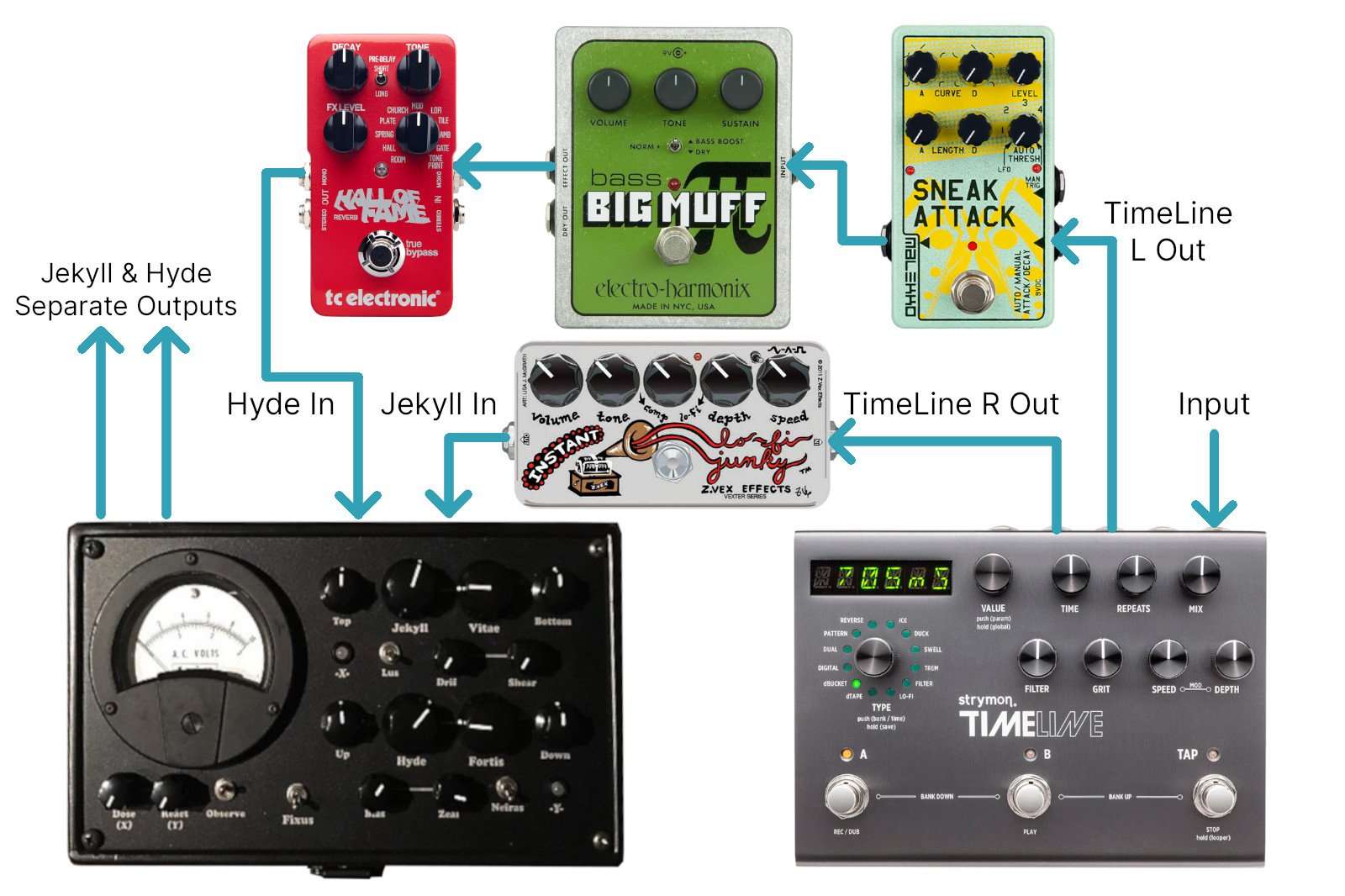 Brian's Signal Chain
Brian's Signal Chain
My goal is to create a somewhat woozy, lop-sided feel that adds subtle differences to each side: check out the audio examples and use headphones for the full effect. The audio example contains three different takes that create a similar atmosphere that is wide, enveloping, and asymmetric. Using the Timeline at the beginning of the chain as the split point, I have one side going through four pedals—Sneak Attack, Bass Big Muff, Hall of Fame reverb, Hyde distortion—while the other side just goes through two—Instant LoFi Junky and Jekyll distortion. By having two modulation effects, the Sneak Attack and LoFi Junky, you can achieve motion that is easily subtle or extreme.
When using pedals to achieve spatial imagery, effects with the ability to go 100% wet is something that can bring life to your chain. In this example, the Sneak Attack is set to LFO mode and the Level knob is dynamically manipulated. This effectively functions as a tremolo with its depth being adjusted and because the Sneak Attack can go fast enough for pseudo-AM modulation—this can open up a variety of sounds. Our reverb can go 100% wet, so when you get those AM sounds, you can smooth them out to create a small static in one ear—or add long pre-delay to a Spring setting for a doppler–slapback type of effect. Using the LoFi Junky, a nice chorus effect can be dialed-in and when leaving one side relatively unaffected, satisfyingly disorienting audio can happen quite easily.
Try your own version of this with any stereo pedal, a tremolo in one channel, and a vibrato/chorus in the other.
Ryan's Tip: Stacked Pitch-Shifters and Ring Modulators
I use my personal pedalboard in a handful of ways; in fact, I use it just as often for reamping/processing tracks from my DAW as I do for processing guitar or other instruments in real time. I see my pedal board as a way of not just shaping the tone of a sound, but as a way of using individual sounds to generate sonic atmospheres with dense layers of internal motion. As such, it contains an assortment of pedals that might seem a bit odd or redundant, with some pedals placed in peculiar parts of the overall signal chain. I have multiple loopers, delay pedals, and several pitch shifters—all run in series. I often change their order so that I can create different sorts of cascading effects; perhaps one day I'll settle on an "optimal" order for them, but for now, I'm having fun exploring different ways of combining them.
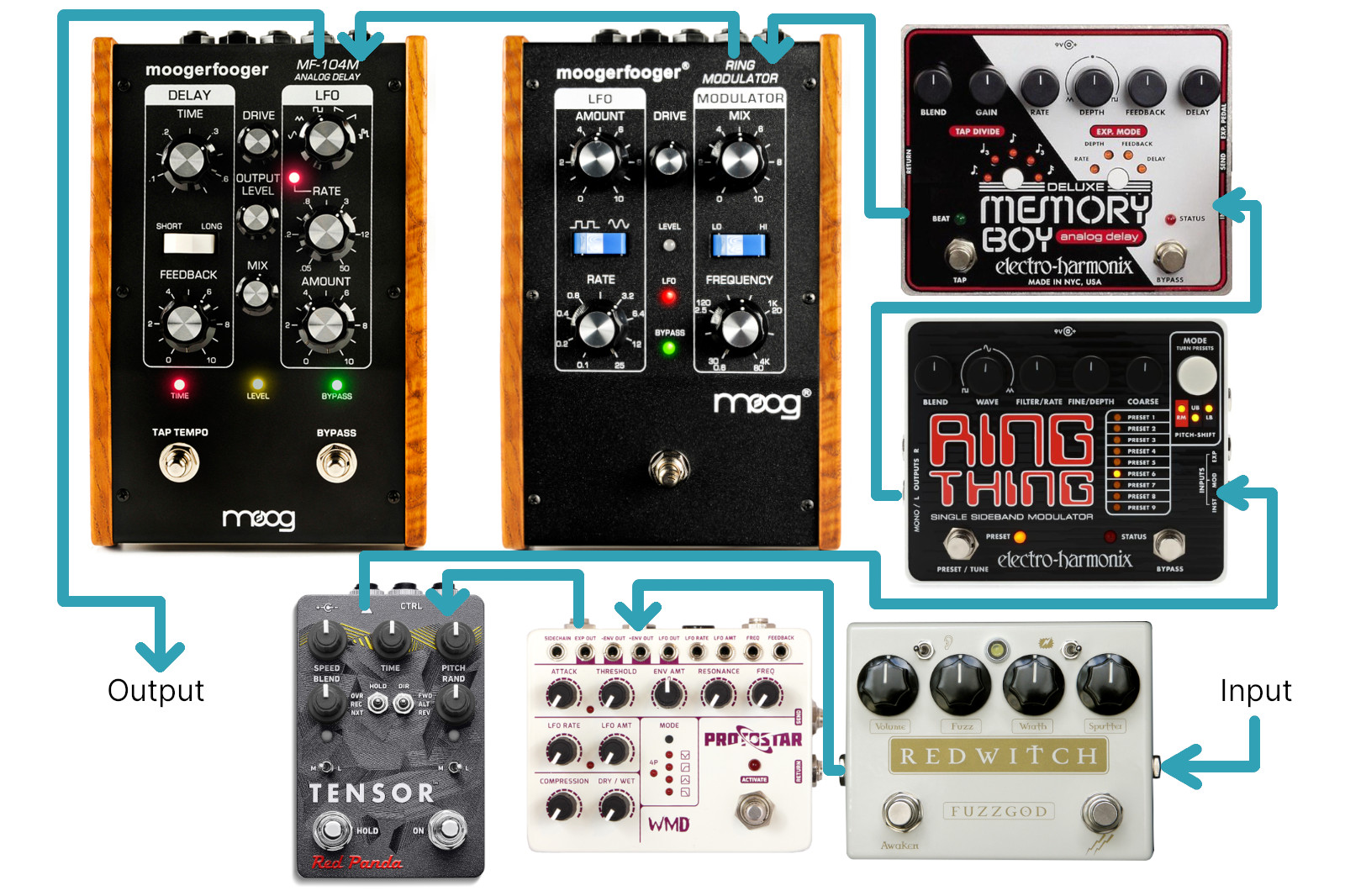 Ryan's Signal Chain
Ryan's Signal Chain
In the accompanying example, I'm running a Fender Jazzmaster into a Red Witch Fuzz God II for a thin, crackly fuzz tone, and then running that through a WMD Protostar filter in lowpass mode, using the internal envelope follower to create a sound with a bright, harsh attack and quickly darkening repeats. This sound then runs into a Red Panda Tensor, providing a sort of reversed, time-stretched octave-up repeat that I dial in by hand using the Blend knob.
From there, the sound passes into an Electro-Harmonix Ring Thing (now discontinued) set to pitch shift mode set to a lower octave shift, allowing me to bring in a lower layer using its Blend knob. Using these two pitch shift effects in series creates a dense, layered multi-octave sound that starts to add audible digital artifacts—using Ring Thing to shift Tensor's already audibly digital time-stretched sound evokes the audio quality of old-school samplers, complete with textural aliasing. From that point, the signal travels through an Electro-Harmonix Deluxe Memory Boy, creating slightly modulated, murky repeats, and then on to a Moog MF-102 ring modulator. The MF-102 adds a sort of high-end sparkle/shimmer/further aliasing-like character to the multi-octave layers and lo-fi delay; the signal then ends with the Moog MF-104M analog delay, which is creating cascading echo effects via the internal downward saw LFO, with repeats smearing constantly downward in pitch.
Again, this pedalboard has a lot of redundancy: multiple ways of pitch shifting, multiple delays, multiple ring modulators, all with relatively similar character—but by having each of these in strategic locations, I can experiment with different types of effect orders without necessarily moving my pedals around. One of the techniques here that I personally use a lot is the idea of multiple analog delays in series with some form of modulation between (in this example, a delay into a ring mod into another delay); by dialing in different sorts of delay modulation on each delay and processing the sound of one of the delays before hitting the second one, I can create all sorts of cascading, smearing textures that almost drip off of my primary sound. I often use pedals to fill in the empty space in an otherwise sparse mix, and have found that multiple delay pedals with a lot of pitch shifting and a lot of modulation in uncommon places can be a very gratifying and lovely way to achieve that goal.
Hands-On Effects Order Manipulation
It's obviously fun to swap around pedals, but the fact remains that large, sprawling pedal boards aren't the ideal solution for everyone, so having every possible effect combination set up at once isn't very practical. Yet at the same time, having a slim assortment of pedals on a curated pedalboard for gigging often requires particular ordering and installation, thus making it a drag to tear down the board when the creative musician wants to explore atypical effect combinations. Plus, while many of these limitations could be removed entirely by foregoing pedals entirely in favor of a modular synthesizer or software plugins, pedals are often simply more practical for instrumentalists whose hands are occupied by playing their instrument. Thankfully, there are now a few options out there for anyone that wants to maintain a tidy pedalboard AND experiment with different effect orders.
Perhaps directly inspired by Eurorack patching and modular synthesizers, Boredbrain's Patchulator is likely the most immediate way to experiment with changing the order of effects on the fly. This octagonally shaped patchbay sports eight pairs of send and return 1/4" jacks on its sides, which are tied to eighth 3.5mm jacks on the top. The most recent versions are built with TRS jacks, making them ideal for streamlined stereo pathways or patching balanced connections with studio outboard gear.
Similar to the Patchulator is the Future Sounds MTX-8, though it makes use of a pin matrix to reroute signals instead of using patch cables. Additionally, all of its inputs and outputs are buffered, meaning that it is possible to split and sum any combination of signals as needed, which make it indispensable for splitting and merging signals on a whim. The MTX8 also comes in another version designed with guitarists in mind, featuring an internal overdrive circuit on the first input channel.
If you're looking for something a tad more robust and automated in your effects pedal ordering, the Boss ES-8 just might be the ticket. Like the options above, it features eight loops in which pedals may be switched in and out on a whim, placed in different orders, and arranged in various series and parallel configurations. But the ES-8 goes the extra mile by offering a vast number of preset slots, where entire chains and combinations of loops may be recalled at an instant. Add in the extensive control connectivity for amps and MIDI I/O, and the ES-8 is possibly the most flexible pedal switching and routing tool available beyond purely working with software or digital modelers and multi-effects units.
Series, Parallel, and Dual Effects
Of course, some pedals themselves might contain multiple circuits (or modes in the case of digital units) within them, and may offer some ways of switching their internal order or signal path. One of my personal favorites is the Empress Echosystem, which can run two of its delay engines in series, parallel, or separately on the left and right channels, thus making it possible to achieve an incredible number of delay textures from a single box.
Instead of sticking with one single signal path, another approach is to branch off into parallel effects chains which later reconvene downstream. Old Blood Noise Endeavors have long championed parallel effects processing, with such pedals as the AB/Y Switcher and Signal Blender being fully dedicated to achieve that lifestyle. But some of their products split and merge signals internally, such as the Visitor, a parallel modulation pedal capable of all kinds of warbly texture. Others like the Whitecap and Blackcap give users the option to choose whether they want series or parallel operation, as both have distinctly different sonic results. In the case of the Whitecap, applying tremolo to an already tremolo-ed signal is going to sound different than two tremolos operating in parallel, while Blackcap does this with both a standard and a harmonic tremolo.
Alternatively, even some pedals which might not facilitate simultaneous modes themselves might at least serve as vehicles for creative signal routings. Delay pedals ranging from the EHX Deluxe Memory Boy to the Strymon TimeLine allow other kinds of effects to be placed within the delay path, meaning that everything from basic filters to pitch and frequency shifters or ring modulators can spice up your delay sounds. On the other hand, powerful processors like the Strymon Mobius and Eventide H9 support sophisticated pre/post routings, where instead of operating as a stereo effect, one channel may be used before the amp and the other in the effects loop. Then on a preset-by-preset basis, different effects may be placed in different parts of the signal chain.
Parting Words of Advice
With an ever-growing number of effect pedals out there, there will always be other ways to combine them together and explore the resulting sounds. Obviously there's no wrong way to do it, and while breaking the so-called "rules" of effects order won't always lead to something extraordinary, there's always a chance of stumbling upon something really cool, and will at least serve as a way of deepening your understanding of your chosen tools. And frankly, a lot of the concepts covered in this article extend beyond pedals themselves, and can be applied to VSTs, Eurorack modules, and so much more.
Of course, pedals simply shape whatever audio is passing through them, so there's no reason why some combination that doesn't spark inspiration on guitar won't work well with vocals, drums, or even field recordings. It's common for multi-instrumentalists to have different pedals for various instruments, and it should stand to reason that different effects chains and orders are the same way. With everything above in mind, keep exploring, experimenting, and discovering—pedals are a joy to work with and an easy way to bring totally new worlds of sound into your artistic practice.


